
Woodworking carbide cutters of tct circular saw blade
- Delivery Time:
- 10 Days
Quantity:
Your message must be between 20 to 2000 characters
Contact NowBasic Info
Basic Info
| Place of Origin: | Hebei, China (Mainland) |
|---|
Product Description
Product Description
Specifications 1 .Experience: 17 years
2. Steel plate: 75 Cr1
3 .Teeth:Ceratizit carbide tips
4 .Grinding: VOLLMER
5: Direct factory
[HUKAY] Woodworking carbide cutters of tct circular saw blade Tct circular saw blade material 1. Tungsten Carbide tip from Ceratizit, Luxemburg. 2. Saw body: High quality steel plate 75cr1. Application: 1. For cutting soft & hard wood 2. Used on push saw, reciprocating saw and table saw. Production line: German Vollmer CNC grinder Advantages: 1: Only make high precision tct circular saw blade, item position in Middle-High end market. 2: Top quality material of carbide tip, from Ceratizit of Luxembourg to prevent over abrasive wear and crack. 3: Saw body with 75 Cr1 have a higher wear resistance.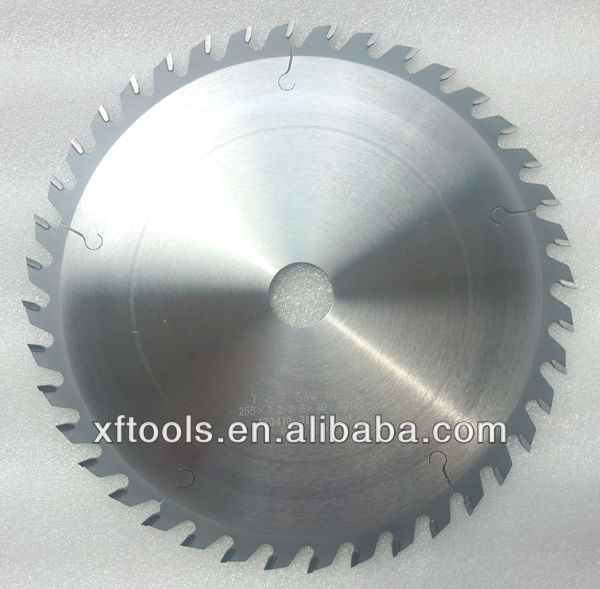
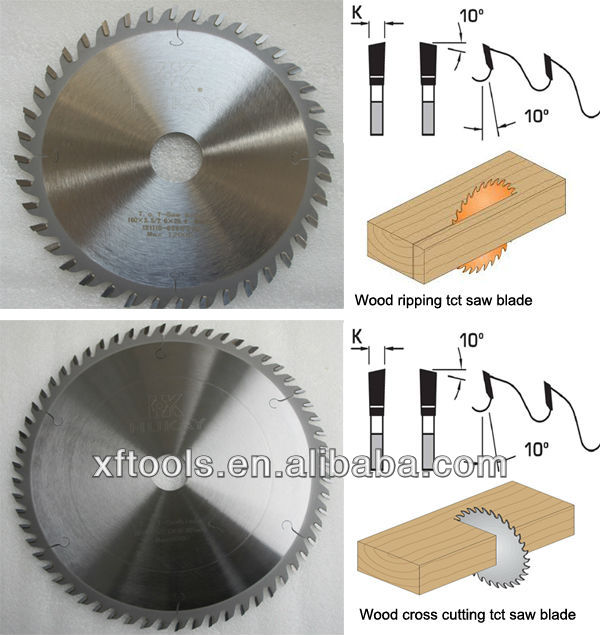 Other products in our factory
Other products in our factory 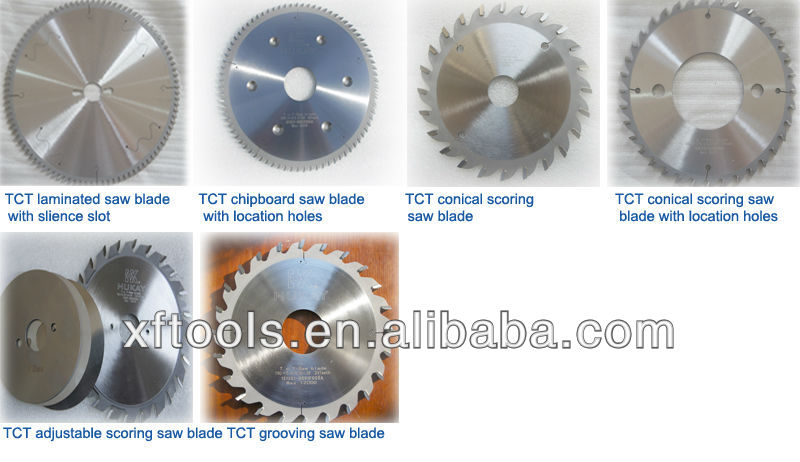
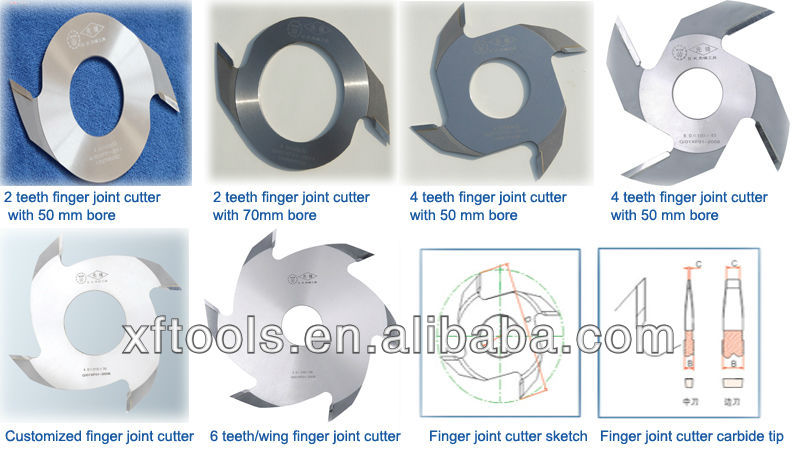 4: Full set of automati equipments, Germany Vollmer professional equipment make sure the saw have a fast, clean cutting with no burrs.
4: Full set of automati equipments, Germany Vollmer professional equipment make sure the saw have a fast, clean cutting with no burrs. 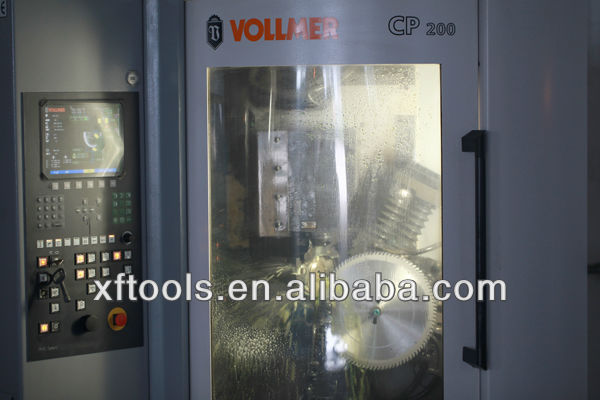 5: Pay more attention on processing technic. Our workers increase raw body flatten procedure, add the grinding times for the sharp teeth, so our saws quality up to first class in China and worldwide
5: Pay more attention on processing technic. Our workers increase raw body flatten procedure, add the grinding times for the sharp teeth, so our saws quality up to first class in China and worldwide 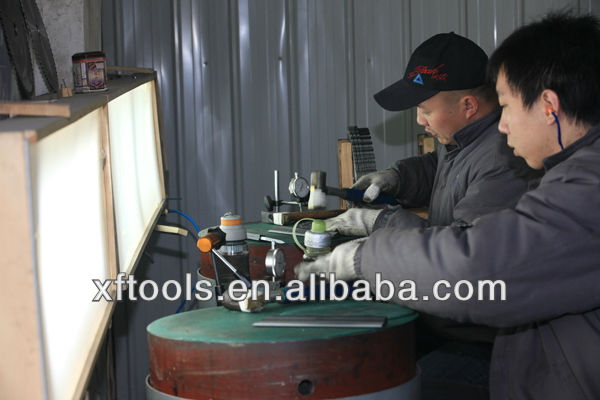 6: Workers with patience, experienced, we lay emphasis on scientific design and continuous optimization of performance for our items
6: Workers with patience, experienced, we lay emphasis on scientific design and continuous optimization of performance for our items 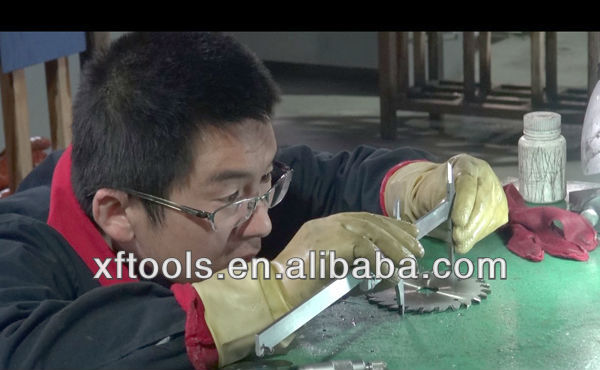 7. Strict quality control, make sure each saw blade have best performance from factory.
7. Strict quality control, make sure each saw blade have best performance from factory. 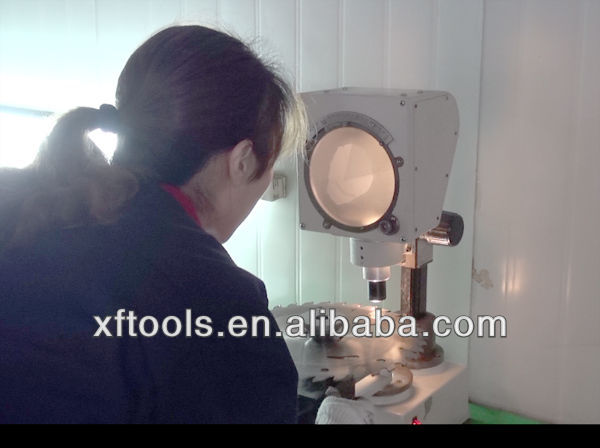 We make the steady quality and competitive price. Contact us and we will satisfied with you! Other Specification for your choice.
We make the steady quality and competitive price. Contact us and we will satisfied with you! Other Specification for your choice.
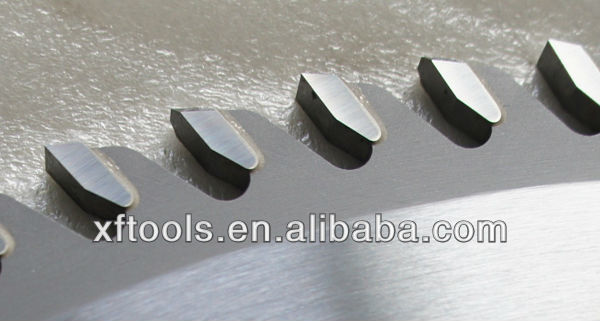 \
\ 
 How to choose the proper saw blade? Circular saw blades are round-shaped cutting implements designed for use with miter saws, table saws, radial arm saws, cut-off saws and standard circular saws. Many circular blades can be used interchangeably between devices. Using the right blade for each job improves performance and efficiency. Manufacturers often label their blades with information about the type of saws, materials and/or applications each one is designed for, giving you a variety of options to consider. Before you learn about your choices, use the following questions to start thinking about your needs: Which saws do you use that require a circular saw blade? What applications/materials do you use your saw(s) for? Do you make slow, precise cuts or fast, rough cuts? What price range are you looking to stay within? Teeth, Dimensions and Construction Circular saw blades vary widely in price. More expensive blades usually have features that extend the longevity of the blade while enhancing performance. Inexpensive blades may dull quickly or produce rougher cuts, so make sure you weigh the benefits of each blade in addition to the initial cost. Dimensions: There are three dimensions to keep in mind when you're shopping for circular saw blades - diameter, arbor size and kerf. The first two dimensions, diameter and arbor size, are determined by the saw. Blade diameters start at 3-3/8", but the most common diameters are 7-1/4" for circular saws, 10" for table saws and 10" and 12" for miter saws. Arbor sizes range from 1/2" to 1". Check your saw or owner's manual to see what size blades you need. Kerf, which tells you how thick or thin a given blade is, gives you a range of options. Thick-kerf blades last longer and can be resharpened, so they tend to be more expensive. Thin-kerf blades are sharper and faster when new but can dull quickly Thin-kerf blades remove less material from the workpiece during cuts Thick-kerf blades hold up to nails better and resist wobble Teeth: In general, blades with more teeth yield a cleaner cut, and blades with fewer teeth deliver faster cuts with rougher edges. The number of teeth should always be considered in relation to the diameter of the blade. Fewer teeth create larger gullets, removing material quickly and reducing clogging, which is important for lengthwise cuts. A small gullet size is best for crosscuts. Tooth grind, shape and hook are also very important in determining the longevity of the blade, quality of cut and recommended applications. Fine-cut blades with a high number of teeth are used for high-quality cuts and thinner materials Tooth hook refers to the attack angle of the tooth (positive, neutral or negative) An aggressive positive hook produces faster cuts but tends to increase tear out Construction: Circular saw blades are usually constructed of steel or carbide-tipped steel. Steel blades are inexpensive but the teeth can dull quickly, so they're often used for more occasional use. Carbide-tipped blades, on the other hand, are extremely durable, with their long life often compensating for the higher price tag. For masonry and metal applications, you'll need an abrasive wheel or diamond blade. Dry-cut diamond blades cut faster than abrasive wheels without heating up the material Carbide-tipped blades require less frequent sharpening, reducing downtime Carbide-tipped blades last up to ten times longer than steel blad Applications: Manufacturers often tell you which saws, materials and/or cuts each of their blades is designed for, eliminating guesswork. The chart below provides a general overview of choices, but most manufacturers offer blades designed for specific materials, such as laminate, aluminum, plywood and many others. The recommended application(s) are usually printed right on the blade for easy identification even after the packaging has been removed. Specialized blades deliver better results for the recommended use than all-purpose blades, but they will require you to change blades more often. Combination blades are popular among users with diverse needs because they minimize downtime due to blade changes, but the resulting crosscuts and rips can be of a lower quality than if specialized blades were used for each cut. Features Expansion Slots: Slots in the blade prevent warping by allowing the metal to expand and cool when it gets hot. Laser-Cut Features: Laser-cutting delivers a more precise result than stamping, enhancing accuracy and performance. Look for laser-cut bodies, arbors and expansion slots on saw blades for higher quality cuts.
How to choose the proper saw blade? Circular saw blades are round-shaped cutting implements designed for use with miter saws, table saws, radial arm saws, cut-off saws and standard circular saws. Many circular blades can be used interchangeably between devices. Using the right blade for each job improves performance and efficiency. Manufacturers often label their blades with information about the type of saws, materials and/or applications each one is designed for, giving you a variety of options to consider. Before you learn about your choices, use the following questions to start thinking about your needs: Which saws do you use that require a circular saw blade? What applications/materials do you use your saw(s) for? Do you make slow, precise cuts or fast, rough cuts? What price range are you looking to stay within? Teeth, Dimensions and Construction Circular saw blades vary widely in price. More expensive blades usually have features that extend the longevity of the blade while enhancing performance. Inexpensive blades may dull quickly or produce rougher cuts, so make sure you weigh the benefits of each blade in addition to the initial cost. Dimensions: There are three dimensions to keep in mind when you're shopping for circular saw blades - diameter, arbor size and kerf. The first two dimensions, diameter and arbor size, are determined by the saw. Blade diameters start at 3-3/8", but the most common diameters are 7-1/4" for circular saws, 10" for table saws and 10" and 12" for miter saws. Arbor sizes range from 1/2" to 1". Check your saw or owner's manual to see what size blades you need. Kerf, which tells you how thick or thin a given blade is, gives you a range of options. Thick-kerf blades last longer and can be resharpened, so they tend to be more expensive. Thin-kerf blades are sharper and faster when new but can dull quickly Thin-kerf blades remove less material from the workpiece during cuts Thick-kerf blades hold up to nails better and resist wobble Teeth: In general, blades with more teeth yield a cleaner cut, and blades with fewer teeth deliver faster cuts with rougher edges. The number of teeth should always be considered in relation to the diameter of the blade. Fewer teeth create larger gullets, removing material quickly and reducing clogging, which is important for lengthwise cuts. A small gullet size is best for crosscuts. Tooth grind, shape and hook are also very important in determining the longevity of the blade, quality of cut and recommended applications. Fine-cut blades with a high number of teeth are used for high-quality cuts and thinner materials Tooth hook refers to the attack angle of the tooth (positive, neutral or negative) An aggressive positive hook produces faster cuts but tends to increase tear out Construction: Circular saw blades are usually constructed of steel or carbide-tipped steel. Steel blades are inexpensive but the teeth can dull quickly, so they're often used for more occasional use. Carbide-tipped blades, on the other hand, are extremely durable, with their long life often compensating for the higher price tag. For masonry and metal applications, you'll need an abrasive wheel or diamond blade. Dry-cut diamond blades cut faster than abrasive wheels without heating up the material Carbide-tipped blades require less frequent sharpening, reducing downtime Carbide-tipped blades last up to ten times longer than steel blad Applications: Manufacturers often tell you which saws, materials and/or cuts each of their blades is designed for, eliminating guesswork. The chart below provides a general overview of choices, but most manufacturers offer blades designed for specific materials, such as laminate, aluminum, plywood and many others. The recommended application(s) are usually printed right on the blade for easy identification even after the packaging has been removed. Specialized blades deliver better results for the recommended use than all-purpose blades, but they will require you to change blades more often. Combination blades are popular among users with diverse needs because they minimize downtime due to blade changes, but the resulting crosscuts and rips can be of a lower quality than if specialized blades were used for each cut. Features Expansion Slots: Slots in the blade prevent warping by allowing the metal to expand and cool when it gets hot. Laser-Cut Features: Laser-cutting delivers a more precise result than stamping, enhancing accuracy and performance. Look for laser-cut bodies, arbors and expansion slots on saw blades for higher quality cuts.
2. Steel plate: 75 Cr1
3 .Teeth:Ceratizit carbide tips
4 .Grinding: VOLLMER
5: Direct factory
[HUKAY] Woodworking carbide cutters of tct circular saw blade Tct circular saw blade material 1. Tungsten Carbide tip from Ceratizit, Luxemburg. 2. Saw body: High quality steel plate 75cr1. Application: 1. For cutting soft & hard wood 2. Used on push saw, reciprocating saw and table saw. Production line: German Vollmer CNC grinder Advantages: 1: Only make high precision tct circular saw blade, item position in Middle-High end market. 2: Top quality material of carbide tip, from Ceratizit of Luxembourg to prevent over abrasive wear and crack. 3: Saw body with 75 Cr1 have a higher wear resistance.

 Other products in our factory
Other products in our factory 
 4: Full set of automati equipments, Germany Vollmer professional equipment make sure the saw have a fast, clean cutting with no burrs.
4: Full set of automati equipments, Germany Vollmer professional equipment make sure the saw have a fast, clean cutting with no burrs.  6: Workers with patience, experienced, we lay emphasis on scientific design and continuous optimization of performance for our items
6: Workers with patience, experienced, we lay emphasis on scientific design and continuous optimization of performance for our items  7. Strict quality control, make sure each saw blade have best performance from factory.
7. Strict quality control, make sure each saw blade have best performance from factory.  We make the steady quality and competitive price. Contact us and we will satisfied with you! Other Specification for your choice.
We make the steady quality and competitive price. Contact us and we will satisfied with you! Other Specification for your choice. | Item No | Diameter (mm) | Kerf (mm) | Body thickness (mm) | Hole diameter (mm) |
No. of teeth (Z)
|
| HK-UN-01 | 255 | 3.2 | 2.2 | 30 | 40/60/80 |
| HK-UN-02 | 255 | 3.2 | 2.2 | 25.4 | 100/120 |
| HK-UN-03 | 305 | 3.2 | 2.2 | 30 | 48 |
| HK-UN-04 | 300 | 3.2 | 2.2 | 30 | 72/96/100/120 |
| HK-UN-05 | 300 | 3.2 | 2.2 | 30 | 60/72/96 with silence slot |
| HK-UN-06 | 300 | 3.2 | 2.2 | 30 | 72 /96 with 6 scale division |
| HK-UN-07 | 350 | 3.5 | 2.5 | 30 | 72/84/96/108 |
| HK-UN-08 | 350 | 4.4 | 3.2 | 30 | 72 |
| HK-UN-09 | 400 | 4.4 | 3.2 | 75 | 72 |
| HK-UN- 10 | 450 | 4.8 | 3.5 | 60 | 72 |
 \
\  How to choose the proper saw blade? Circular saw blades are round-shaped cutting implements designed for use with miter saws, table saws, radial arm saws, cut-off saws and standard circular saws. Many circular blades can be used interchangeably between devices. Using the right blade for each job improves performance and efficiency. Manufacturers often label their blades with information about the type of saws, materials and/or applications each one is designed for, giving you a variety of options to consider. Before you learn about your choices, use the following questions to start thinking about your needs: Which saws do you use that require a circular saw blade? What applications/materials do you use your saw(s) for? Do you make slow, precise cuts or fast, rough cuts? What price range are you looking to stay within? Teeth, Dimensions and Construction Circular saw blades vary widely in price. More expensive blades usually have features that extend the longevity of the blade while enhancing performance. Inexpensive blades may dull quickly or produce rougher cuts, so make sure you weigh the benefits of each blade in addition to the initial cost. Dimensions: There are three dimensions to keep in mind when you're shopping for circular saw blades - diameter, arbor size and kerf. The first two dimensions, diameter and arbor size, are determined by the saw. Blade diameters start at 3-3/8", but the most common diameters are 7-1/4" for circular saws, 10" for table saws and 10" and 12" for miter saws. Arbor sizes range from 1/2" to 1". Check your saw or owner's manual to see what size blades you need. Kerf, which tells you how thick or thin a given blade is, gives you a range of options. Thick-kerf blades last longer and can be resharpened, so they tend to be more expensive. Thin-kerf blades are sharper and faster when new but can dull quickly Thin-kerf blades remove less material from the workpiece during cuts Thick-kerf blades hold up to nails better and resist wobble Teeth: In general, blades with more teeth yield a cleaner cut, and blades with fewer teeth deliver faster cuts with rougher edges. The number of teeth should always be considered in relation to the diameter of the blade. Fewer teeth create larger gullets, removing material quickly and reducing clogging, which is important for lengthwise cuts. A small gullet size is best for crosscuts. Tooth grind, shape and hook are also very important in determining the longevity of the blade, quality of cut and recommended applications. Fine-cut blades with a high number of teeth are used for high-quality cuts and thinner materials Tooth hook refers to the attack angle of the tooth (positive, neutral or negative) An aggressive positive hook produces faster cuts but tends to increase tear out Construction: Circular saw blades are usually constructed of steel or carbide-tipped steel. Steel blades are inexpensive but the teeth can dull quickly, so they're often used for more occasional use. Carbide-tipped blades, on the other hand, are extremely durable, with their long life often compensating for the higher price tag. For masonry and metal applications, you'll need an abrasive wheel or diamond blade. Dry-cut diamond blades cut faster than abrasive wheels without heating up the material Carbide-tipped blades require less frequent sharpening, reducing downtime Carbide-tipped blades last up to ten times longer than steel blad Applications: Manufacturers often tell you which saws, materials and/or cuts each of their blades is designed for, eliminating guesswork. The chart below provides a general overview of choices, but most manufacturers offer blades designed for specific materials, such as laminate, aluminum, plywood and many others. The recommended application(s) are usually printed right on the blade for easy identification even after the packaging has been removed. Specialized blades deliver better results for the recommended use than all-purpose blades, but they will require you to change blades more often. Combination blades are popular among users with diverse needs because they minimize downtime due to blade changes, but the resulting crosscuts and rips can be of a lower quality than if specialized blades were used for each cut. Features Expansion Slots: Slots in the blade prevent warping by allowing the metal to expand and cool when it gets hot. Laser-Cut Features: Laser-cutting delivers a more precise result than stamping, enhancing accuracy and performance. Look for laser-cut bodies, arbors and expansion slots on saw blades for higher quality cuts.
How to choose the proper saw blade? Circular saw blades are round-shaped cutting implements designed for use with miter saws, table saws, radial arm saws, cut-off saws and standard circular saws. Many circular blades can be used interchangeably between devices. Using the right blade for each job improves performance and efficiency. Manufacturers often label their blades with information about the type of saws, materials and/or applications each one is designed for, giving you a variety of options to consider. Before you learn about your choices, use the following questions to start thinking about your needs: Which saws do you use that require a circular saw blade? What applications/materials do you use your saw(s) for? Do you make slow, precise cuts or fast, rough cuts? What price range are you looking to stay within? Teeth, Dimensions and Construction Circular saw blades vary widely in price. More expensive blades usually have features that extend the longevity of the blade while enhancing performance. Inexpensive blades may dull quickly or produce rougher cuts, so make sure you weigh the benefits of each blade in addition to the initial cost. Dimensions: There are three dimensions to keep in mind when you're shopping for circular saw blades - diameter, arbor size and kerf. The first two dimensions, diameter and arbor size, are determined by the saw. Blade diameters start at 3-3/8", but the most common diameters are 7-1/4" for circular saws, 10" for table saws and 10" and 12" for miter saws. Arbor sizes range from 1/2" to 1". Check your saw or owner's manual to see what size blades you need. Kerf, which tells you how thick or thin a given blade is, gives you a range of options. Thick-kerf blades last longer and can be resharpened, so they tend to be more expensive. Thin-kerf blades are sharper and faster when new but can dull quickly Thin-kerf blades remove less material from the workpiece during cuts Thick-kerf blades hold up to nails better and resist wobble Teeth: In general, blades with more teeth yield a cleaner cut, and blades with fewer teeth deliver faster cuts with rougher edges. The number of teeth should always be considered in relation to the diameter of the blade. Fewer teeth create larger gullets, removing material quickly and reducing clogging, which is important for lengthwise cuts. A small gullet size is best for crosscuts. Tooth grind, shape and hook are also very important in determining the longevity of the blade, quality of cut and recommended applications. Fine-cut blades with a high number of teeth are used for high-quality cuts and thinner materials Tooth hook refers to the attack angle of the tooth (positive, neutral or negative) An aggressive positive hook produces faster cuts but tends to increase tear out Construction: Circular saw blades are usually constructed of steel or carbide-tipped steel. Steel blades are inexpensive but the teeth can dull quickly, so they're often used for more occasional use. Carbide-tipped blades, on the other hand, are extremely durable, with their long life often compensating for the higher price tag. For masonry and metal applications, you'll need an abrasive wheel or diamond blade. Dry-cut diamond blades cut faster than abrasive wheels without heating up the material Carbide-tipped blades require less frequent sharpening, reducing downtime Carbide-tipped blades last up to ten times longer than steel blad Applications: Manufacturers often tell you which saws, materials and/or cuts each of their blades is designed for, eliminating guesswork. The chart below provides a general overview of choices, but most manufacturers offer blades designed for specific materials, such as laminate, aluminum, plywood and many others. The recommended application(s) are usually printed right on the blade for easy identification even after the packaging has been removed. Specialized blades deliver better results for the recommended use than all-purpose blades, but they will require you to change blades more often. Combination blades are popular among users with diverse needs because they minimize downtime due to blade changes, but the resulting crosscuts and rips can be of a lower quality than if specialized blades were used for each cut. Features Expansion Slots: Slots in the blade prevent warping by allowing the metal to expand and cool when it gets hot. Laser-Cut Features: Laser-cutting delivers a more precise result than stamping, enhancing accuracy and performance. Look for laser-cut bodies, arbors and expansion slots on saw blades for higher quality cuts. Related Keywords
Related Keywords








